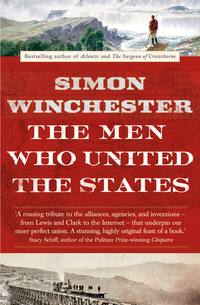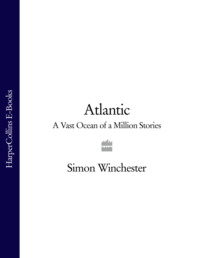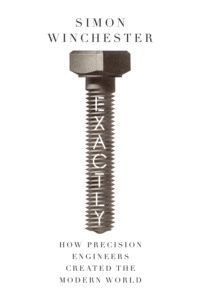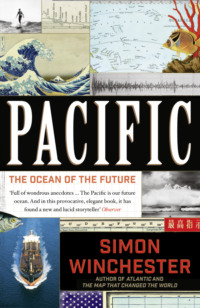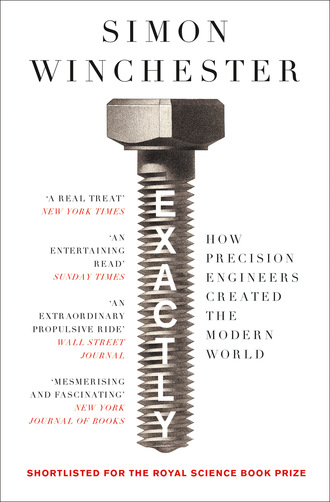
Полная версия
Exactly
Then, by the purest accident, John Wilkinson, in Bersham, asked for an engine to be built for him, to act as a bellows for one of his iron forges—and in an instant, he saw and recognized Watt’s steam-leaking problem, and in an equal instant, he knew he had the solution: he would apply his cannon-boring technique to the making of cylinders for steam engines.
So, without taking the precautionary step of filing a new patent for this entirely new application of his method, he proceeded to do with the Watt cylinders exactly what he had done with the naval guns. He had Watt’s workmen haul a solid iron cylinder blank the seventy miles across to Bersham. He then strapped the blank (in this case, for the very engine that he, as customer, eventually wanted, so six feet long and thirty-eight inches in diameter) onto a firmly fixed stage, and then secured it with heavy chains to make certain it did not move by so much as a fraction of an inch. He then fashioned a massive cutting tool of ultrahard iron that was three feet across (which should in theory have produced a cut that left a thirty-eight-inch-diameter cylinder with one-inch-thick walls) and bolted it securely to the end of a stiff iron rod eight feet long. This he supported at both ends and mounted onto a heavy iron sleigh that could be ratcheted slowly and steadily into the huge iron workpiece.
As soon as he was ready to begin working the piece, he directed, through a hose, a water-and-vegetable-oil mixture both to cool the thrashing metals and to wash away any fragments of cut iron; opened the water valve for the millrace and wheel that would set the rod and its cutting tool turning; and slowly and steadily, notch by notch by notch, set the rod moving forward until its cutting edge began chewing away at the face of the iron billet.
After a full day of searing heat and grinding din, the cylinder was cut. The tool, hot but barely blunted, was withdrawn. The hole, three feet in diameter, looked smooth and clean, straight and true. Using a set of chains and blocks, he placed the heavy cylinder (now rather less heavy, as so much iron had been bored away) upward, on its end. The piston, fractionally less than three feet in diameter itself and smeared with lubricating grease, was carefully lifted up and over the lip of the cylinder and down into its depths.
There was, I like to think, a round of cheers, for the piston slipped noiselessly and snugly into the cylinder and could be lifted up and down with ease and without any apparent leakage of air, of grease, of anything. It then took Watt just a few days, once the disassembled pieces were brought back to his works in Soho, to mount the cylinder in pride of place in what would now be his, and the world’s, first working full-scale single-action engine. He and his engineers then added all the supplementary parts (the pipes, the second condenser, the boiler, the rocking arm, the governor, the water tank, the flywheel) and then loaded the firebox with coal, added a primer, lit the fire, and, once the water was hot enough to set steam pouring from the safety line, opened the main valve.
With an enormous chuff-chuff-chuff, the piston began to move up and down, up and down, out of the newly machined cylinder. The rocking beam above then began to oscillate up and back; the connecting rod on the far side started to move up and down, up and down; the set of eccentric sun-and-moon gears on the flywheel started to move; and then the huge wheel itself, tons of solid iron that would in effect store the engine’s power, started to turn.
Within moments, with the governor’s shiny couplet of balls spinning merrily to keep matters in check, the engine was roaring along at full power, thumping and thudding and whirring and chuffing—and now all perfectly visibly because, for the first time since Watt had begun his experiments, there was no leaking steam. The engine was working at maximum efficiency: it was fast, it was powerful, and it was doing just what was demanded of it. Watt beamed with delight. Wilkinson had solved his problem, and the Industrial Revolution—we can say now what those two never imagined—could now formally begin.
And so came the number, the crucial number, the figure that is central to this story, that which appears at the head of this chapter and which will be refined in its exactitude in all the remaining parts of this story. This is the figure of 0.1—one-tenth of an inch. For, as James Watt later put it, “Mr. Wilkinson has bored us several cylinders almost without error, that of 50 inch diameter … does not err the thickness of an old shilling at any part.” An old English shilling had a thickness of a tenth of an inch. This was the tolerance to which John Wilkinson had ground out his first cylinder.
He might in fact have done even better than that. In another letter, written rather later—by which time Wilkinson had bored no fewer than five hundred cylinders for Watt’s engines, which were being snapped up by factories and mills and mines all over the country and beyond—the Scotsman boasted that Wilkinson had “improved the art of boring cylinders so that I promise upon a seventy two inch cylinder being not farther distant from absolute truth than the thickness of an old sixpence at the worst part.” An old English sixpence was even slighter: half of a tenth of an inch, or 0.05 inches.
Yet this is a quibble. Whether the thickness of a shilling coin or the thinness of an old sixpence, it does not really matter. The fact is that a whole new world was being created. Machines had now been made that would make other machines, and make them with accuracy, with precision. All of a sudden, there was an interest in tolerance, in the clearance by which one part was made to fit with or into another. This was something quite new, and it begins, essentially, with the delivery of that first machine on May 4, 1776. The central functioning part of the steam engine was possessed of a mechanical tolerance never before either imagined or achieved, a tolerance of 0.1 inches, and maybe even better.
ON THE FAR side of the Atlantic Ocean, and precisely two months after the culmination of these events, on July 4, 1776, a whole new political world was to be created. The United States of America was born, with implications unimagined by all.
It was very shortly thereafter that the new nation’s principal representative in Europe, Thomas Jefferson, heard tell of these miraculous mechanical advances and started to ponder how his own faraway country might well take advantage of developments that appeared to him to have the very greatest potential.
Maybe, Jefferson declared, they could form the basis for a new trade well suited to his new country. Maybe, replied the engineers in response, we can do better than we have done already, and using their own arcane language of numbers, they translated their ambitions: maybe we can make and machine and manufacture metal pieces in America to a tolerance much greater than John Wilkinson’s 0.1. Maybe we can be adroit enough to reach down to 0.01. Maybe better than that—maybe to 0.001. Who could possibly know? As with the new nation, these visionary engineers wondered, so perhaps with the new machines.
As it happened, the engineers—in England, mainly, but also, and most significantly for the next part of the story, in France—would do a great deal better than they ever supposed. The genie of accuracy was now out of the bottle. True precision was now out of the gate, and moving fast.
Chapter 2
(TOLERANCE: 0.0001)
Extremely Flat and Incredibly Close
It is to the exactitude and accuracy of our machine tools that our machinery of the present time owes its smoothness of motion and certainty of action.
—SIR WILLIAM FAIRBAIRN, BT. (1862), REPORT OF THE BRITISH ASSOCIATION FOR THE ADVANCEMENT OF SCIENCE
On the north side of London’s Piccadilly, overlooking Green Park and sandwiched between the quarters of the aged and imperturbable Cavalry Club to the west and a rather more ephemeral Peruvian-style ceviche restaurant on its eastern side, stands Number 124, these days an elegant but somewhat anonymous structure providing offices for the discreet and service apartments for the wealthy.
Since 1784, when this far-western end of the great boulevard was still ripe for development, the address had been the home and atelier of a cabinet, engine, and lock maker named Joseph Bramah. On fair-weather days some six years after its opening, when Bramah and Company was an established and familiar small firm, modest gatherings of curious passersby would assemble outside to peer into the front bow window, puzzling at a challenge so difficult that it went unanswered for more than the sixty subsequent years.
There was just a single object on view in the window, placed on a velvet cushion like a religious icon. It was a padlock, oval shaped, of modest size, and with a smooth and uncomplicated external appearance. On its face was written, in a small script legible only to those who pressed their faces close to the window glass, the following words: THE ARTIST WHO CAN MAKE AN INSTRUMENT THAT WILL PICK OR OPEN THIS LOCK SHALL RECEIVE 200 GUINEAS THE MOMENT IT IS PRODUCED.
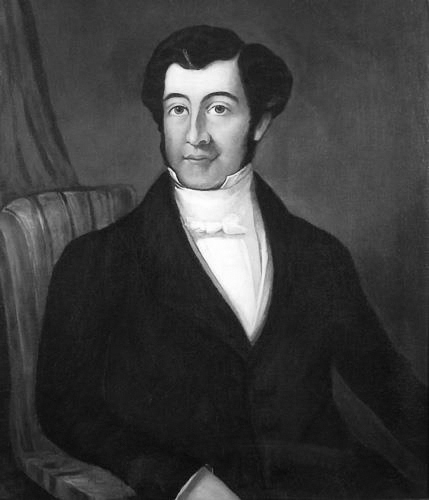
Joseph Bramah, locksmith extraordinaire, also invented the fountain pen, a device for keeping beer cool and under pressure in a pub basement, and a machine for counting banknotes.
The designer of this boastfully unbreakable lock was the firm’s principal, Joseph Bramah. Its maker, however, was not Bramah but a then-nineteen-year-old former blacksmith’s apprentice named Henry Maudslay, whom Bramah had taken on the previous year, entirely because of Maudslay’s reputation for having a formidable skill in delicate machining.
It would not be until 1851 that the Bramah lock was successfully—although, as we shall see in a later chapter, controversially—picked and the very handsome pledge* redeemed. And in the years leading up to this event (which only their descendants would survive to witness), these two men, Bramah and Maudslay, proved themselves to be engineers supreme. They invented all manner of intriguing new devices, and they effectively and independently wrote the rule books for the precise world that was beginning to emerge as a consequence of (or, at least, in the wake of) John Wilkinson’s achievements with his cylinder-boring machine at Bersham. Some of the two men’s inventions have faded away into history; some others, however, have survived as the foundations on which much of today’s most sophisticated engineering achievements would eventually be built.
Though Maudslay remains today the better-known figure, with a legacy recognized by most engineers, Bramah was at the time perhaps the more showily ingenious of the pair. His first invention was dreamed up while he lay in bed after a fall, and must rank as the least romantic: for a London population that sorely needed an improvement in public hygiene, he built water closets, and he patented his ideas for a system of flaps and a float and valves and pipes that made the device both self-cleansing (flushing, indeed, for the first time) and free from the usual risk of freezing in winter that created unpleasant results for all. He made a small fortune from this creation, selling six thousand in the first twenty years of production, and a Bramah WC was still the centerpiece of the civilized English middle-class bathroom right up until Victoria’s Jubilee, a hundred years later.
Bramah’s interest in locks, which required far more intricacy and precise workmanship than a toilet, of course, seems to have started when he was elected in 1783 a member of the newly formed (and still there, in its original home) Royal Society for the Encouragement of Arts, Manufactures and Commerce.* What is now simply the Royal Society of Arts, the RSA, back in the eighteenth century had six divisions: Agriculture, Chemistry, Colonies and Trade, Manufactures, Mechanicks (spelled thus), and most quaintly, the Polite Arts. Bramah not unnaturally opted to attend most of the Mechanicks meetings and, soon after joining, rocketed to prominence by the simple act of picking a lock. Not so simply, actually: in September 1783, a Mr. Marshall had submitted for consideration what he declared was a formidably unpickable lock, and had a local expert named Truelove worry away at it with a quiverful of special tools for an hour and a half, before accepting defeat. Then, from the back of the audience stepped Joseph Bramah, who quickly fashioned a pair of instruments and opened the lock in fifteen minutes flat. A buzz of excitement went around the room: they were clearly in the presence of a most Mechanickal man.
Locks were a British obsession at the time. The social and legislative changes that were sweeping the country in the late eighteenth century were having the undesirable effect of dividing society quite brutally: while the landed aristocracy had for centuries protected itself in grand houses behind walls and parks and ha-has, and with resident staff to keep mischief at bay, the enriched beneficiaries of the new business climate were much more accessible to the persistent poor. They and their possessions were generally both visible and, especially in the fast-growing cities, nearby; they tended to live in houses and on streets within earshot and slingshot of the vast armies of the impoverished. Envy was abroad. Robbery was frequent. Fear was in the air. Doors and windows needed to be bolted. Locks had to be made, and made well. A lock such as Mr. Marshall’s, pickable in fifteen minutes by a skilled man, and by a desperate and hungry man maybe in ten, was clearly not good enough. Joseph Bramah decided he would design and make a better one.
He did so in 1784, less than a year after picking the Marshall lock. His patent made it almost impossible for a burglar with a wax-covered key blank, the tool most favored by the criminals who could use it to work out the position of the various levers and tumblers inside a lock, to divine what was beyond the keyhole, inside the workings. Bramah’s design, which he patented that August, had the various levers inside a lock rise or fall to different positions when the key was inserted and turned to release the bolt, but then had those same levers return to their initial positions once the bolt had been shot. The effect of this was to make the device almost burglar-proof, for no amount of foraging with a wax key blank would ever allow a picklock to work out where the levers needed to be (as they weren’t there anymore) in order to free the bolt.
Once Bramah had come up with this basic mechanical premise, it remained for him, with great cleverness and elegance, to form the entire lock into a cylindrical shape, with its levers not so much rising and falling under the influence of gravity as moving in and out along the radii of the cylinder under the impress of the key’s various teeth, and then moving back to their original positions with the aid of a spring, one for each lever. The entire lock could thus be rendered as a small tube-shaped brass barrel, which could be easily fitted into a tube-shaped cavity in a wooden door or an iron safe, and with the deadbolt flush to the door’s outer edge (when the lock was open) or settled into its brass cavity in the door frame (when securely closed).
Joseph Bramah would go on to invent many more contraptions and concepts during his life, many of them having nothing to do with locks, but involving his particular other fascination with the behavior of liquids when subjected to pressure. He invented the hydraulic press, for example, with its vast importance in industry worldwide. More trivially, he launched onto the market a primitive form of fountain pen* and drew designs for a propelling pencil; more lastingly, he made the beer engine, which is still employed by the more traditionally minded innkeepers, and which would allow beer kept cool in a cellar to be pressure-delivered to thirsty customers in the bar above. (This invention obviated the need for the bartender to stagger up and down the cellar stairs, lugging fresh barrels of ale.) Draft beer drinkers today have little cause to remember the name “Bramah,” though there is a pub in Lancashire named for him. Likewise, few banknote printers know that it was Joseph Bramah who made the first machine that could cleverly ensure that their thousands of identical bills each bore a different sequential number. He also made an engine for planing large wooden planks, another for making paper, and he forecast that, one day, large screws would be used to propel big ships through the water.
Yet it is really only by way of his lock making that Bramah’s name has now formally entered the English language. True, one can still find in literature references to a Bramah pen and a Bramah lock—the Duke of Wellington wrote admiringly of each, as did Walter Scott and Bernard Shaw. Yet when the word is used alone—and Dickens did on numberless occasions, in The Pickwick Papers, in Sketches by Boz, in The Uncommercial Traveller—it is a reminder that at least for the Victorian citizenry, his was an eponym: one used a Bramah to open a Bramah, one’s home was secured with a Bramah, one gave a Bramah to a favored friend so he or she might visit at all hours, come what may. Only when Mr. Chubb and Mr. Yale arrived on the scene (noted by the Oxford English Dictionary as first making it into the language in 1833 and 1869, respectively) did Joseph Bramah’s lexical monopoly hit the buffers.
What made a Bramah lock so good was its vastly complicated internal design, of course, but what made it so lastingly good was the precision of its manufacture. And that was less the work of its inventor than of the man—the boy, really—whom Bramah hired to make copious numbers of his device and to make them well, to make them fast, and to make them economically. Henry Maudslay was eighteen years old when Bramah lured him away as an apprentice: he would go on to become one of the most influential figures in the early days of precision engineering, his influence being felt to this day both in his native Britain and around the world.
The very young Maudslay, “a tall, comely young fellow” by the time Bramah hired him, cut his teeth in the Woolwich Royal Arsenal in East London. Working first as a twelve-year-old powder monkey—small boys, fleet of foot, were used by the Royal Navy to bring gunpowder up from the ships’ magazines to the gun deck—he was then moved to the carpenter’s shop, only to pronounce himself bored by the inaccuracy of wood. It was starkly clear to all who employed him that the youngster much preferred metal. They looked away when he smuggled himself into the dockyard smithy, and they said nothing when he developed a sideline in making a range of useful and very handsome trivets out of cast-off iron bolts.
IN 1789, JOSEPH Bramah cut an anxious figure. The political situation across the Channel was causing an influx of terrified French refugees, most of them bound for London, where the more nervously xenophobic residents of England’s capital suddenly started to demand ever more security for their homes and businesses. Bramah, with his patent-protected monopoly, was caught in a bind: he alone could make his locks, but neither he nor any engineer he could find had the ability to make them in sufficient numbers at a low enough price. Most men who called themselves engineers may have been adept at the cruder crafts—at thumping ingots of heat-softened iron with heavy hammers and then working to shape the crudely formed results with anvils, chisels, and, most especially, files—but few had a great feel for delicacy, for the construction of (and the word had only recently been adopted) mechanisms.
Change was coming, though. Workers at the smithies of eighteenth-century London were a close-knit group, and word eventually did reach Bramah that a particular youngster at Woolwich was startlingly unlike his older peers and, rather than bashing hunks of iron, was apparently crafting metal pieces of an unusual, fastidious daintiness. Bramah interviewed the teenage Maudslay. Though taking to him immediately, the former was only too well aware that the custom was for any would-be entrant to the trade to serve a seven-year apprenticeship. However, commercial need trumped custom: with would-be patrons beating down his door back on Piccadilly, Bramah had no time to spare for the niceties, decided to take a chance, and hired the youngster on the spot. His decision was to change history.
Henry Maudslay turned out to be a transformative figure. First of all, he solved Bramah’s supply problems in an inkling—but not by the conventional means of hiring workers who would make the locks one by one through the means of their own craftsmanship. Instead, and just like John Wilkinson two hundred miles west and thirteen years earlier, Maudslay created a machine to make them. He made a machine tool: in other words, a machine to make a machine (or, in this case, a mechanism). He built a whole family of machine tools, in fact, that would each make, or help to make, the various parts of the fantastically complicated locks Joseph Bramah had designed. They would make the parts, they would make them fast and well and cheaply, and they would make them without the errors that handcrafting and the use of hand tools inevitably bring in their train. The machines that Maudslay made would, in other words, make the necessary parts with precision.
Three of his lock-making devices can be seen today in the Science Museum in London. One is a saw that cut the slots in the barrels; another—perhaps less a machine tool than a means of ensuring that production went along at high speed, with every part made exactly the same—is a quick-grip, quick-release vise, a fixture that would hold the bolt steady while it was milled by a series of cutters mounted on a lathe; and the third is a particularly clever device, powered by a foot-operated treadle, that would wind the lock’s internal springs and hold them under tension as they were positioned and secured in place until the outer cover, a well-shined brass plate with the flamboyant signatures of the Bramah Lock Company of 124 Piccadilly, London, inscribed on its face, was bolted on to finish the job.
A fourth and, some would argue, most supremely important machine tool component also started to make its widespread appearance around this time. It would shortly become an integral part of the lathe, a turning device that, much like a potter’s wheel, has been a mechanical aid to the betterment of human life since its invention in pharaonic Egypt. Lathes evolved very slowly indeed over the centuries. Perhaps the biggest improvement came in the sixteenth century, with the concept of the leadscrew. This was a long and (most often, in early times) wooden screw that was mounted under the main frame of the lathe and could be turned by hand to advance the movable end of the lathe toward or away from the fixed end. It could do so with a degree of precision; one turn of the handle might advance the movable part of the lathe by an inch, say, depending on the pitch of the leadscrew. It gave wood turners working on a lathe a much greater degree of control, and allowed them to produce things (chair legs, chess pieces, handles) of great decorative beauty, symmetric loveliness, and baroque complexity.
Henry Maudslay then improved the lathe itself by many orders of magnitude—first by making it of iron, forging its structure stoutly and heavily, and at a stroke allowing it not merely to machine wooden items, but also to create symmetry out of shapeless billets of hard metal, which the flimsy lathes of old were incapable of doing. This alone might have been sufficient for us to remember the man, but then Maudslay employed one further component on his working lathes, a component whose origins are debated still, however, with the tenor of the debate pointing to an endless argument that complicates the historiography of precision and precision engineering.
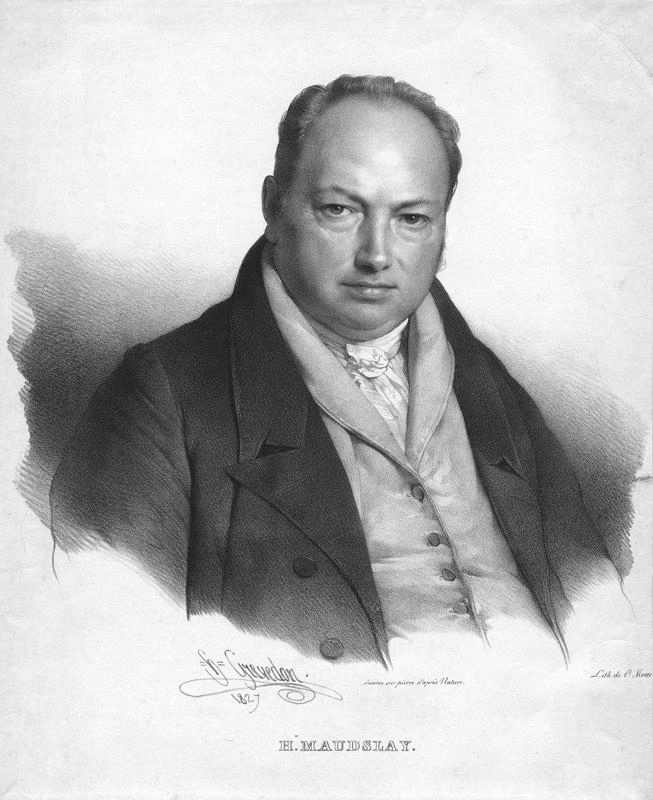
Henry Maudslay, once a “tall, comely fellow,” machined the innards of Bramah’s locks and went on to become the founding father of precision toolmaking, mass production, and the key engineering concept of achieving perfect flatness.


